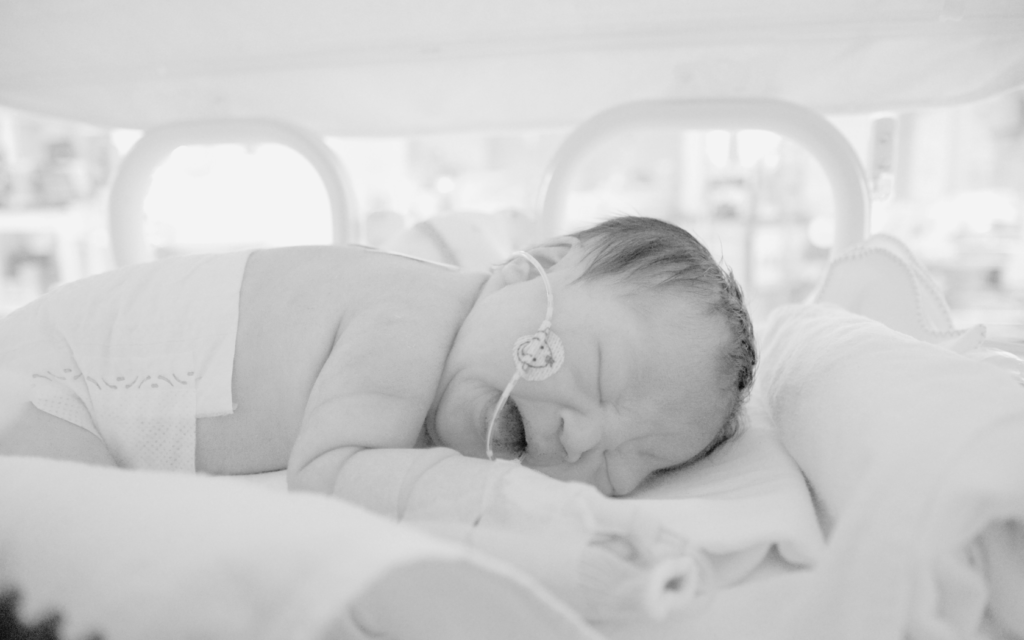HIE cooling therapy may seem like an odd medical practice. Lowering a baby’s body temperature? That’s downright dangerous, isn’t it? Not if it’s done in a safe, controlled way—in that case, it can be life-saving.
Cooling therapy can have dramatic positive effects on some babies with hypoxic-ischemic encephalopathy. Let’s talk about it…

What is HIE Cooling Therapy?
Also known as therapeutic hypothermia, cooling therapy is a medical treatment that can minimize long-term brain damage hypoxic-ischemic encephalopathy (HIE). Babies with moderate to severe HIE are susceptible to developing lifelong conditions like cerebral palsy. This therapy can lower a baby’s risk of having permanent disabilities.
Cooling therapy for HIE involves cooling down the baby’s body temperature. The target temperature range will be between 32°C (89.6°F) and 36°C (96.8°F). The baby will remain at that temperature for a set period, usually 12 to 72 hours.
Making a baby cold might seem counter-intuitive. However, this carefully controlled process can help protect the baby’s brain and other organs. It reduces the metabolic rate, decreases inflammation, and limits the release of harmful chemicals.
Recent studies have shown cooling therapy improves survival rates and neurological outcomes for babies with HIE. In a study where half of the babies underwent therapeutic hypothermia and half didn’t, the results were;
- Only 28% of babies treated with cooling therapy died before age 7.
- 44% of babies who were not treated with cooling therapy died before age 7.
- There were also fewer cases of severe disability in the hypothermia treatment group.
The Cooling Therapy Process
HIE cooling therapy is a promising treatment. But it has to be done in a safe, precise way.
Here’s an overview of the process:
- Doctors assess the baby to determine if they’re a candidate for HIE cooling therapy.
- There are two ways to apply cooling therapy for HIE. With whole body cooling, the infant lies on a special blanket. It lowers the temperature of their entire body. With selective cooling, the baby wears a cooling cap.
- Doctors lower the baby’s body temperature and keep it in the target range for a set number of hours.
- Next, it’s time to rewarm the baby back to normal body temperature. This is done slowly to prevent complications.
- Throughout the entire process, doctors must monitor the baby’s vital signs. They also keep an eye on the infant’s neurological status and other parameters. They’ll keep the baby sedated and comfortable, and provide respiratory and cardiovascular support if needed.
- No treatment is complete without an evaluation. Once it’s over, doctors evaluate how the baby responds to it. Then they’ll determine the next steps in their care, which may include further medical intervention or rehabilitation therapy.

How Cooling Therapy for HIE Works
Hypoxic-ischemic encephalopathy (HIE) occurs when there is a lack of oxygen and blood flow to the brain, typically during childbirth. When brain cells are deprived of oxygen and nutrients during an HIE event, they become stressed and may die.
Lowering the body temperature reduces the metabolic demand of these cells. It helps preserve them until blood flow and oxygen levels can be restored.
Also, HIE often triggers an inflammatory response in the brain. This can cause further damage. However, research shows cooling therapy can reduce inflammation.
When should babies receive HIE cooling therapy?
HIE should be initiated as soon as possible after birth. Within the first six hours is ideal. Originally, researchers thought that neonatal cooling wasn’t effective after six hours. However, the newest research challenges this theory. It may still have some benefits for up to 24 hours after birth.
In any case, the medical community is in agreement that “the sooner the better” applies to HIE cooling therapy. Delaying treatment for a baby with severe HIE can be catastrophic. It can mark the difference between living life with a minor neurological impairment and a severe one. This is why neglecting to provide cooling therapy to an HIE baby who needs it can constitute medical negligence.
The Academic Medical Center Patient Safety Organization (AMC PSO) suggests that cooling therapy should be applied when a baby meets all three of the following criteria:
- The baby’s less than 6 hours old and spent at least 36 weeks in the womb.
- Has at least one of the following: a complication before delivery, an Apgar score of five or lower at 10 minutes of life, severe acidosis, had to be resuscitated at birth, or their umbilical cord gas shows abnormal base excess within 60 minutes of birth.
- Shows signs of seizures or encephalopathy (abnormal neurological function).

Legal Help for Preventable HIE Injuries
We invite you to contact our birth injury lawyers if:
- You believe the negligent conduct of medical staff caused your child’s HIE.
- Doctors failed to provide cooling therapy for HIE when it was needed. As a result, your child has severe injuries.
Hampton & King has decades of experience with birth injury cases involving HIE. We take pride in obtaining maximum compensation for families affected by medical malpractice. Whenever you’re ready, we’re ready to hear your story.




